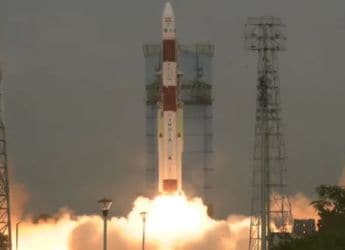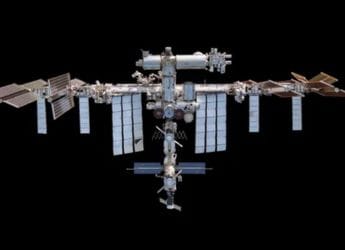- Home
- Science
- Science News
- NASA's DART Mission First Step Towards Preventing Possible Asteroid Armageddon, Indian Scientists Say
NASA's DART Mission First Step Towards Preventing Possible Asteroid Armageddon, Indian Scientists Say
NASA will now observe Dimorphos using ground-based telescopes to confirm that DART's impact altered the asteroid's orbit around Didymos.

Photo Credit: NASA
DART spacecraft successfully crashed into an asteroid on Tuesday
NASA's mission to deflect asteroid is a step towards preparing the world for a potential future asteroid strike like the one which killed the dinosaurs some 66 million years ago, the chances of which are very slim in our lifetime, Indian scientists said.
In a first-of-its-kind mission, the Double Asteroid Redirection Test (DART) spacecraft successfully crashed into an asteroid on Tuesday to test whether space rocks that might threaten Earth in the future could be nudged safely out of the way.
DART – the world's first planetary defence technology demonstration — targeted the asteroid moonlet Dimorphos, a small body just 160 metres in diameter.
"We are surrounded by several asteroids and comets that orbit our Sun. Very few of them are potentially hazardous to Earth. Hence, It is better to prepare our defenses to avoid such asteroids on a collision course with Earth in the future," said Chrisphin Karthick, a scientist at the Indian Institute of Astrophysics (IIA), Bengaluru.
Karthick, who is involved in the DART project, noted that the mission "certainly is a step towards" preparing the world for a potential future event like the one which is believed to have led to the extinction of dinosaurs some 66 million years ago.
"This successful DART mission is an example of that. We now know to precisely aim the spacecraft for such a small body. We can also prepare ourselves for the larger body from the post-impact observations of this DART mission," Karthick told PTI.
Dimorphos orbits a larger 780-metre asteroid called Didymos. Neither asteroid poses a threat to Earth. By comparison, the dinosaur-killing asteroid that hit Earth was about 10 kilometers in diameter.
The DART mission's one-way trip, confirmed NASA, can successfully navigate a spacecraft to intentionally collide with an asteroid to deflect it, a technique known as kinetic impact.
Goutam Chattopadhyay, a senior scientist at NASA's Jet Propulsion Laboratory (JPL) in the US also noted that the mission will help to prepare for a future-threatening asteroid.
"DART is an experimental mission to try out a concept of deflecting an asteroid. The idea is, if we can encounter these asteroids whose trajectory is towards us and we do that at a sufficient distance from the Earth, then a minor deflection will be enough to change the path of the asteroid," he added.
However, scientists noted that most of the asteroids, which are somewhat significant in size and can cause damage on impact with the Earth, have a minuscule chance of hitting the planet.
"However, the probability of that is non-zero and we must always be vigilant. There is always a possibility that a big one might be headed towards us and the question becomes, what would be our approach and how we could mitigate that. That's why these programs are important," Chattopadhyay told PTI.
"At least for the next century, there is no such threat from the known asteroids that can cause mass casualties," said Karthick, adding that this risk assessment is, however, based on the asteroids known to science so far.
Small asteroids are always hitting the Earth all the time but they burn due to the heat generated in the atmosphere. However, for sufficiently large asteroids, that is not the case as the outer core will burn but there will be sufficient mass left to create damage.
The team will now observe Dimorphos using ground-based telescopes to confirm that DART's impact altered the asteroid's orbit around Didymos.
Researchers expect the impact to shorten Dimorphos' orbit by about 1 per cent, or roughly 10 minutes; precisely measuring how much the asteroid was deflected is one of the primary purposes of the full-scale test.
"Post impact, the team will observe Dimorphos using ground-based telescopes to confirm that DART's impact altered the asteroid's orbit around Didymos," Karthick said.
"The expected output of the impact is to shorten Dimorphos' orbit by about 1 per cent, or roughly 10 minutes. One of the primary goals is to measure the deflection of the asteroid's orbit," he added.
However, Chattopadhyay said whether the mission has been able to deflect the orbit of the asteroid will be known only once all the data has been collected.
"I would emphasise that our calculations and small-scale lab experiments show that it might work well,". he added NASA has a multi prong approach to monitor Near Earth Asteroids (NEAs). The space agency initiated observations program in 1998. Most discoveries are supported by ground-based telescopic surveys, "We primarily use radars and lidars for this. Mostly they are ground-based systems. However, our existing satellites in space are also used to image and track these objects," the scientist added.
Lidar is a method for determining distance by targeting an object or a surface with a laser and measuring the time for the reflected light.
"The DART mission is humanity's first attempt to alter the trajectory of an asteroid by crashing a human made object into it. Today's successful impact is a big step forward in that direction.
"However, to know the eventual success of this concept, we have to wait a few more years by when any significant change in the trajectory would be clearly apparent," said Dibyendu Nandi, space scientist at Indian Institutes of Science Education and Research, Kolkata.
Catch the latest from the Consumer Electronics Show on Gadgets 360, at our CES 2026 hub.
Related Stories
- Samsung Galaxy Unpacked 2025
- ChatGPT
- Redmi Note 14 Pro+
- iPhone 16
- Apple Vision Pro
- Oneplus 12
- OnePlus Nord CE 3 Lite 5G
- iPhone 13
- Xiaomi 14 Pro
- Oppo Find N3
- Tecno Spark Go (2023)
- Realme V30
- Best Phones Under 25000
- Samsung Galaxy S24 Series
- Cryptocurrency
- iQoo 12
- Samsung Galaxy S24 Ultra
- Giottus
- Samsung Galaxy Z Flip 5
- Apple 'Scary Fast'
- Housefull 5
- GoPro Hero 12 Black Review
- Invincible Season 2
- JioGlass
- HD Ready TV
- Laptop Under 50000
- Smartwatch Under 10000
- Latest Mobile Phones
- Compare Phones
- Vivo Y500i
- OnePlus Turbo 6V
- OnePlus Turbo 6
- Itel Zeno 20 Max
- OPPO Reno 15 Pro Mini 5G
- Poco M8 Pro 5G
- Motorola Signature
- Vivo Y50e 5G
- Lenovo Yoga Slim 7x (2025)
- Lenovo Yoga Slim 7a
- Realme Pad 3
- OPPO Pad Air 5
- Xiaomi Watch 5
- Huawei Watch 10th Anniversary Edition
- Acerpure Nitro Z Series 100-inch QLED TV
- Samsung 43 Inch LED Ultra HD (4K) Smart TV (UA43UE81AFULXL)
- Asus ROG Ally
- Nintendo Switch Lite
- Haier 1.6 Ton 5 Star Inverter Split AC (HSU19G-MZAID5BN-INV)
- Haier 1.6 Ton 5 Star Inverter Split AC (HSU19G-MZAIM5BN-INV)

















